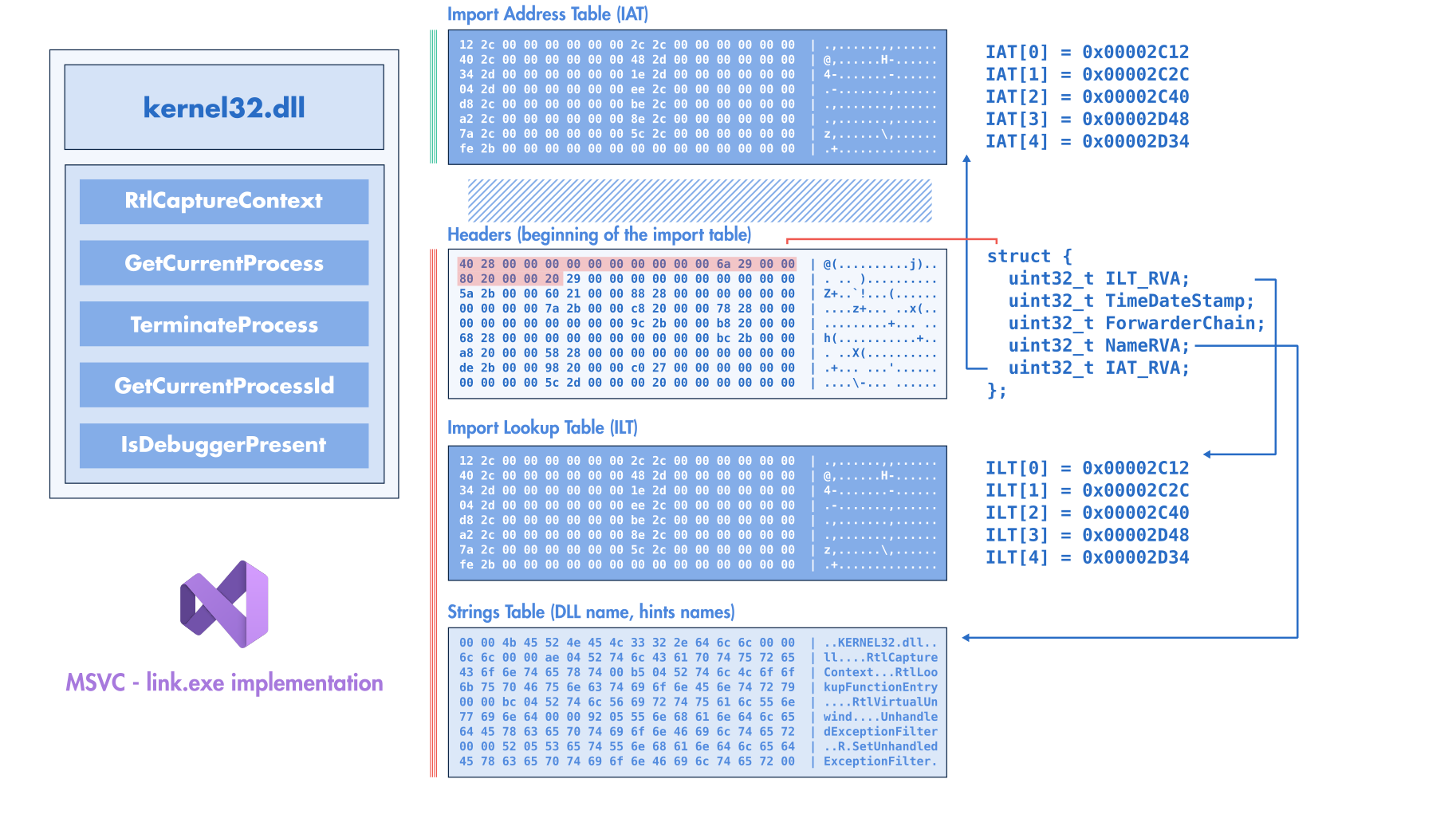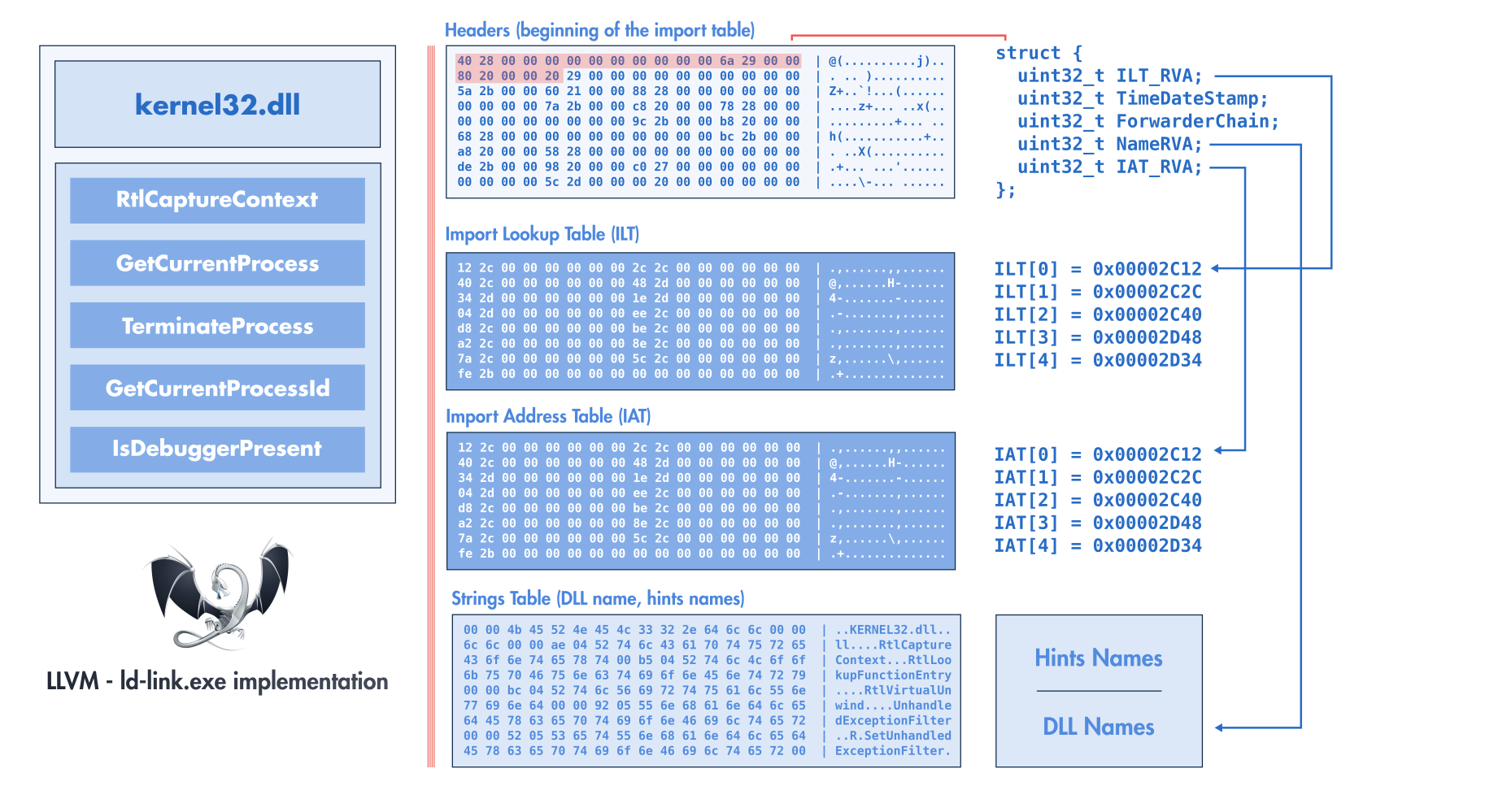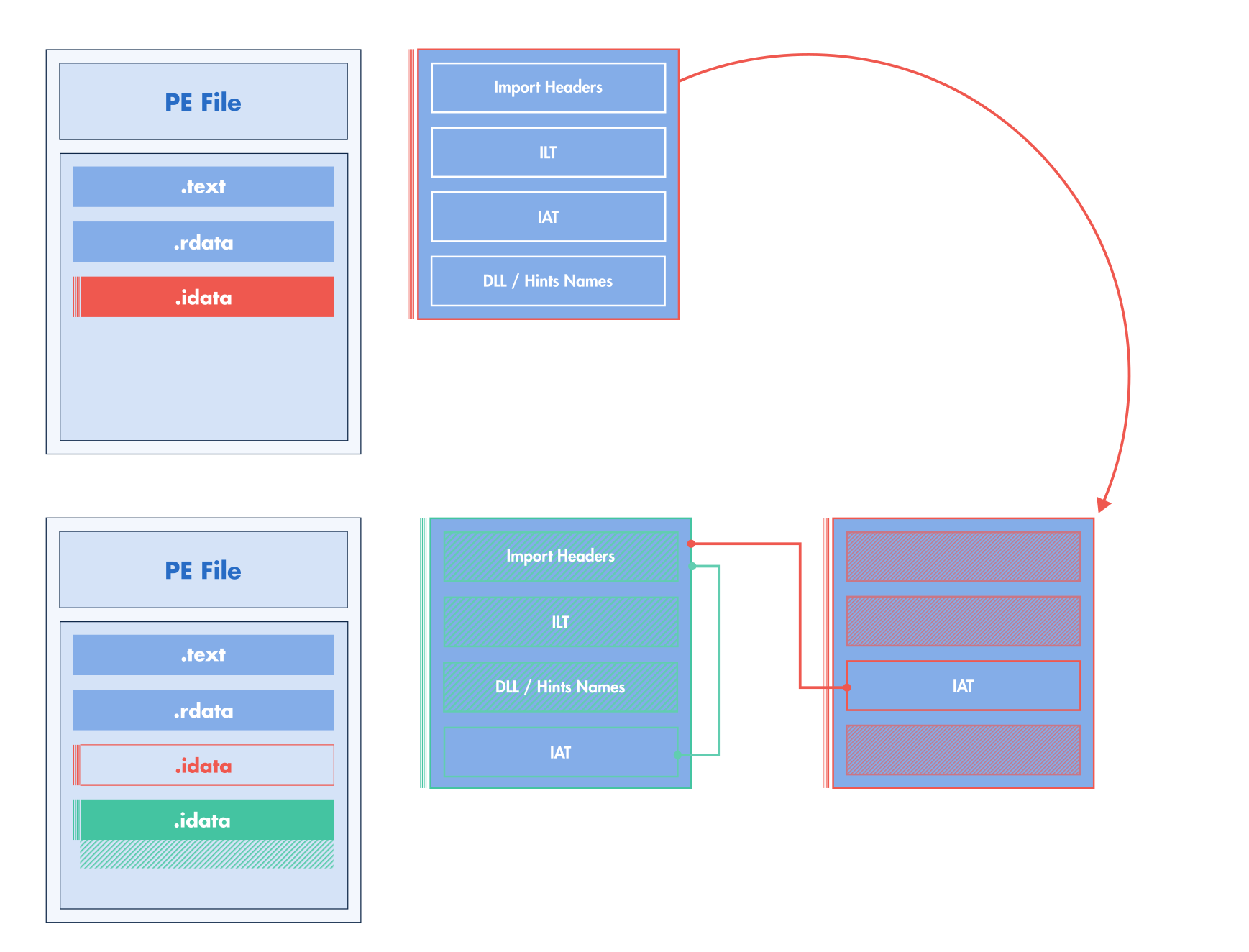Imports Modification¶
This section describes the different operations supported by LIEF to modify the PE import table. Please note that any operation not mentioned in this page can be considered as not supported or might lead to a corrupted binary.
Operation |
Supported |
|---|---|
Extend original IAT |
|
Extend original ILT |
Implementation Update
Compared to the previous of LIEF, the import table modification has been completely redesigned to be more reliable when modifying or rebuilding a PE binary.
Introduction¶
Modifying the PE import table generically and reliably can be challenging
due to its flexible layout and strong dependency on the assembly
code.
To better understand these challenges and how they are addressed in LIEF,
let’s start with the layout of the import table generated by the MSVC linker
(link.exe):

Import Table Layout (MSVC/link.exe)¶
IMPORT_TABLE value.
The RVA of this data directory points to the beginning of the raw structure
describing the import table while the data directory’s size provides the length
of this table.
For each imported library (e.g. kernel32.dll), the import header references
3 locations:Address (RVA) of the import lookup table (ILT)
RVA of the imported library name (e.g. RVA of the string
kernel32.dll)Address (RVA) of the import address table (IAT)
The IAT and the ILT point to an array of integers (pointer width) ending with a zero. In the on-disk PE binary, both tables are filled with an RVA referencing the imported function name (or an ordinal value).
For instance, if the binary imports kernel32.dll!GetCurrentProcess and
kernel32.dll!TerminateProcess then we would have the following ILT/IAT:
uintptr_t IAT[3] = {
RVA("GetCurrentProcess"),
RVA("TerminateProcess"),
0
};
uintptr_t ILT[3] = {
RVA("GetCurrentProcess"),
RVA("TerminateProcess"),
0
};
When Windows loads the binary and resolves its imports, it fills the IAT with the resolved address of the imported functions:
uintptr_t IAT[3] = {
- RVA("GetCurrentProcess"),
- RVA("TerminateProcess"),
+ 0x7ff7bfdb3f00, // GetCurrentProcess resolved address
+ 0x7ff7ceab4f00, // TerminateProcess resolved address
0
};
On the other hand, the ILT is kept unchanged when the binary is loaded (according to the Microsoft documentation). The import header references three RVA but the PE format (and the Windows loader) do not enforce any specific ordering between them. This means that you can have the ILT before the IAT or vice versa.
The figure Import Table Layout (MSVC/link.exe) depicts the layout when linking a PE binary
with MSVC’s link.exe. From this figure, we can notice that the IATs come first,
then we have the import headers that are followed by the ILT, and finally,
the strings (DLL names, imported function names).
This layout can change with the linker used to generate the final PE file. In the figure Import Table Layout (LLVM/ld-link.exe), we can observe that the IAT follows the ILT which is the default order for PE binary generated by LLVM ld-link.exe.

Import Table Layout (LLVM/ld-link.exe)¶
Since we can’t assume any predefined layout or ordering of the import table elements, we can’t safely recreate a new table at the same locations as the original one without risking overriding important data. In addition, if we add new imports or imported functions, the modified import table would no longer fit in the original location.
To address these constraints, a generic solution consists of relocating the import table elsewhere in the binary.
Builder Config
We can relocate the import headers, the ILTs and the strings (DLL names and import names), but we can’t relocate the IAT arbitrarily in the binary. The import table is used to inform the Windows loader about the functions required by the program to correctly execute its code. When the loader resolves an imported function, its address is written in the IAT and the assembly code accesses this IAT with the following stubbing instructions:
jmp [rip + #IAT_FIXUP]; // e.g. jmp *IAT[3];
or
mov rax, [rip + #IAT_FIXUP];
call rax;
If we relocate the IAT elsewhere in the binary (without other considerations), then the instructions referencing the IAT are no longer valid.
There are solutions to address this problem and one of them consists of creating trampolines between the original IAT and the new IAT location. This approach has been used in the former implementation of LIEF and you can read this blog post Washi’s Injecting Code using Imported Functions into Native PE Files for more details.
The new approach used by LIEF relocates all the elements of the import table: headers, ILT, and strings but it keeps the original IATs at the same.

LIEF import table relocation¶
By keeping the original IATs in the same place, we avoid creating trampolines that require generating assembly. On the other hand, this approach introduces constraints on the way the imports can be modified. Especially, we need to make sure that the untouched IAT is still consistent with the assembly code that uses it.
Removing Import¶
import lief
pe: lief.PE.Binary = ...
pe.remove_import("kernel32.dll")
config = lief.PE.Builder.config_t()
config.imports = True
pe.write("new.exe", config)
#include <LIEF/PE.hpp>
std::unique_ptr<LIEF::PE::Binary> pe;
pe->remove_import("kernel32.dll");
LIEF::PE::Builder::config_t config;
config.imports = true;
pe->write("new.exe", config);
let mut pe: lief::pe::Binary;
pe.remove_import("kernel32.dll");
let config = lief::pe::builder::Config::default();
config.imports = true;
pe.write_with_config("new.exe", config);
Removing an imported function¶
import lief
pe: lief.PE.Binary = ...
kernel32 = pe.get_import("kernel32.dll")
kernel32.remove_entry("IsDebuggerPresent")
config = lief.PE.Builder.config_t()
config.imports = True
pe.write("new.exe", config)
#include <LIEF/PE.hpp>
std::unique_ptr<LIEF::PE::Binary> pe;
LIEF::PE::Import* kernel32 = pe->get_import("kernel32.dll");
kernel32->remove_entry("IsDebuggerPresent");
LIEF::PE::Builder::config_t config;
config.imports = true;
pe->write("new.exe", config);
let mut pe: lief::pe::Binary;
if let Some(mut kernel32) = pe.import_by_name("kernel32.dll") {
kernel32.remove_entry_by_name("IsDebuggerPresent");
}
let config = lief::pe::builder::Config::default();
config.imports = true;
pe.write_with_config("new.exe", config);
Since this operation drops an entry from IAT but we can’t shrink the
table without patching the assembly (or making trampolines), the workaround
consists of replacing the removed entry with (any) other previous entry.
For instance, if we remove IsDebuggerPresent from Kernel32.dll, the IAT
changes as follows:
- Before:
// Import Address Table of Kernel32.dll uintptr_t IAT[] = { RVA("GetCurrentProcess"), RVA("IsDebuggerPresent"), RVA("TerminateProcess"), 0 };
- After:
// Import Address Table of Kernel32.dll uintptr_t IAT[] = { RVA("GetCurrentProcess"), RVA("GetCurrentProcess"), RVA("TerminateProcess"), 0 };
Implicit Operation
LIEF is implicitly doing this padding during the build process.
This works because we can reuse the IAT entry associated with the deleted entry as a placeholder for any other imported function. Windows allows duplicated symbols for a given import so it’s perfectly correct to duplicate an import and thus, keep the same length for the IAT.
Creating a new import¶
import lief
pe: lief.PE.Binary = ...
stdio = pe.add_import("api-ms-win-crt-stdio-l1-1-0.dll")
stdio.add_entry("puts")
config = lief.PE.Builder.config_t()
config.imports = True
pe.write("new.exe", config)
#include <LIEF/PE.hpp>
std::unique_ptr<LIEF::PE::Binary> pe;
LIEF::PE::Import& stdio = pe->add_import("api-ms-win-crt-stdio-l1-1-0.dll");
LIEF::PE::ImportEntry& _puts = stdio.add_entry("puts");
LIEF::PE::Builder::config_t config;
config.imports = true;
pe->write("new.exe", config);
let mut pe: lief::pe::Binary;
let mut stdio = pe.add_import("api-ms-win-crt-stdio-l1-1-0.dll");
let _puts = stdio.add_entry_by_name("puts");
let config = lief::pe::builder::Config::default();
config.imports = true;
pe.write_with_config("new.exe", config);
As depicted in the figure LIEF import table relocation, this
modification introduces a new IAT located close to the relocated import table.
This new IAT contains values for the newly imported functions (in this example puts).
Hence, it is in this table that imported functions are resolved by the
Windows loader.
The new IAT wrapping up user-created imports is generated during the LIEF’s write operation. Especially, there is no reliable way to know the address of the new IAT before the write operation.
import lief
def iat_resolution_cbk(pe: lief.PE.Binary, imp: lief.PE.Import, entry:
lief.PE.ImportEntry, rva: int):
# Process
return
pe: lief.PE.Binary = ...
stdio = pe.add_import("api-ms-win-crt-stdio-l1-1-0.dll")
stdio.add_entry("puts")
config = lief.PE.Builder.config_t()
config.imports = True
config.resolved_iat_cbk = iat_resolution_cbk
pe.write("new.exe", config)
#include <LIEF/PE.hpp>
std::unique_ptr<LIEF::PE::Binary> pe;
LIEF::PE::Import& stdio = pe->add_import("api-ms-win-crt-stdio-l1-1-0.dll");
LIEF::PE::ImportEntry& _puts = stdio.add_entry("puts");
LIEF::PE::Builder::config_t config;
config.imports = true;
config.resolved_iat_cbk =
[] (LIEF::PE::Binary& pe, LIEF::PE::Import& imp,
LIEF::PE::ImportEntry& entry, uint64_t RVA) -> void
{
// Process
return;
}
pe->write("new.exe", config);
Rust Bindings
This callback is not (yet) available in Rust.
Nanobind Leaks
Because of Python reference counting, you might experience Nanobind warnings
about leaked objects. You can turn off these warnings using lief.disable_leak_warning()
uint64_t RVA is the address in the
IAT where the address of the resolved function () is going
to be stored by the loader.For instance, we can trace these addresses as follows:
def iat_resolution_cbk(pe: lief.PE.Binary, imp: lief.PE.Import,
entry: lief.PE.ImportEntry, rva: int):
print(f"{imp.name}!{entry.name}: 0x{rva:010x}")
# [...]
stdio = dll.add_import("api-ms-win-crt-stdio-l1-1-0.dll")
stdio.add_entry("puts")
stdio.add_entry("__p__commode")
stdio.add_entry("_set_fmode")
# [...]
Which can results of the following output:
api-ms-win-crt-stdio-l1-1-0.dll!puts: 0x000046c9e2
api-ms-win-crt-stdio-l1-1-0.dll!__p__commode: 0x000046c9ea
api-ms-win-crt-stdio-l1-1-0.dll!_set_fmode: 0x000046c9f2
Given this output, the IAT address of puts is located at the RVA 0x000046c9e2.
This information can be used to patch sections that would need to know this
address:
def iat_resolution_cbk(pe: lief.PE.Binary, imp: lief.PE.Import,
entry: lief.PE.ImportEntry, rva: int):
code = pe.get_section(".injected")
patch(code, rva)
Adding a new imported function¶
LIEF can also be used to add a function to an existing import, but it needs to be done carefully to avoid corrupting the binary.
Since we can’t/don’t extend the original IAT of the import in which we want the new function, the trick consists of adding a new import with the same name as the existing import and adding this function to the duplicated import.
// Original Import
* kernel32.dll
│
├── GetCurrentProcessId IAT[0]
│
├── GetCurrentThreadId IAT[1]
│
└── GetModuleHandleW IAT[2]
// Duplicated import
* kernel32.dll
│
└── GetStartupInfoW NEW IAT[0]
│
└────────-> New Import
So the code is really similar to Creating a new import.
import lief
pe: lief.PE.Binary = ...
kernel32 = pe.add_import("kernel32.dll")
kernel32.add_entry("GetStartupInfoW")
config = lief.PE.Builder.config_t()
config.imports = True
config.resolved_iat_cbk = ...
pe.write("new.exe", config)
#include <LIEF/PE.hpp>
std::unique_ptr<LIEF::PE::Binary> pe;
LIEF::PE::Import& kernel32 = pe->add_import("kernel32.dll");
LIEF::PE::ImportEntry& _GetStartupInfoW = kernel32.add_entry("GetStartupInfoW");
LIEF::PE::Builder::config_t config;
config.imports = true;
config.resolved_iat_cbk = ...;
pe->write("new.exe", config);
let mut pe: lief::pe::Binary;
let mut kernel32 = pe.add_import("kernel32.dll");
let _GetStartupInfoW = kernel32.add_entry_by_name("GetStartupInfoW");
let mut config = lief::pe::builder::Config::default();
config.imports = true;
pe.write_with_config("new.exe", config);